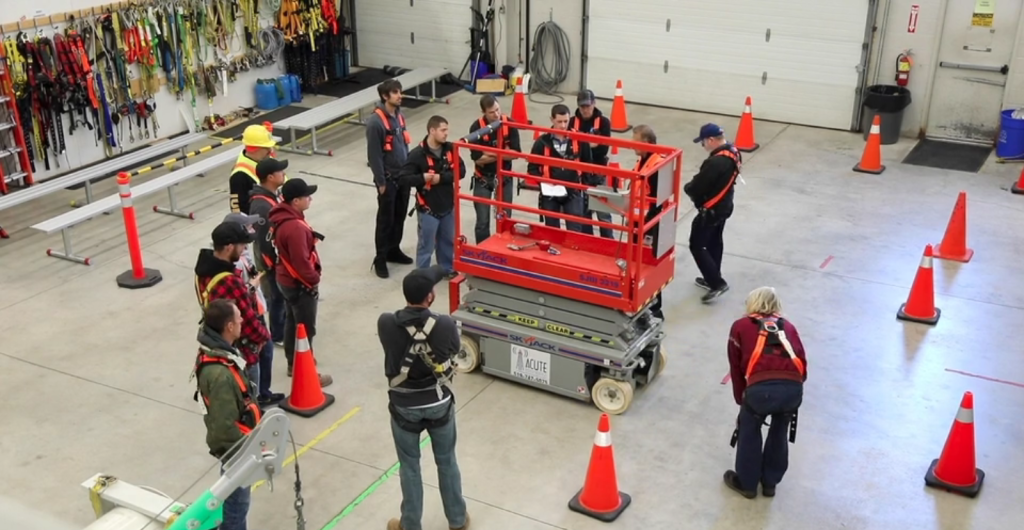Whether you are an employee, supervisor, manager, or business owner, everyone deserves to work in a safety compliant workplace. But, how do you do this? And why is it so important? Read on for answers to these questions and more in the article below.
Click on each corresponding link to jump ahead:
- How Can You Create a Safety Compliant Workplace?
- Why Should You Create a Safety Compliant Workplace?
- A Guide to Addressing Workplace Safety Hazards
ACUTE Environmental is your go-to resource for all things safety training. Simply contact us today to set up your safety training!
A Safety Compliant Workplace


Whether you work in a construction related industry or in an office setting, your workplace must be safety compliant.
1. How Can You Create a Safety Compliant Workplace
Ensuring workplace safety compliance is essential for all jobs whether you work in a hands-on blue-collar job or in an office setting.
Here are comprehensive guidelines for achieving safety compliance in both settings:
A) For Construction/Blue-Collar Jobs

If you work in a construction or blue collar industry, ensure your workplace is safety compliant.
Personal Protective Equipment (PPE)
- Mandate the use of appropriate PPE such as hard hats, gloves, safety glasses, and steel-toed boots.
- Provide and maintain PPE, and ensure employees are trained on proper usage.
Equipment Safety
- Conduct regular inspections and maintenance of all machinery and equipment.
- Implement lockout/tag-out procedures to prevent accidental machine startup.
Fall Protection
- Install guardrails, safety nets, or personal fall arrest systems for employees working at heights.
- Train employees on proper fall protection techniques.
Hazard Communication
- Label hazardous substances properly and maintain Safety Data Sheets (SDS) for chemicals.
- Train workers on the safe handling and storage of hazardous materials.
Site Safety Plans
- Develop comprehensive safety plans for each construction project, addressing specific hazards and controls.
- Assign a safety officer for each construction site.
Regular Inspections and Audits
- Conduct routine safety inspections and audits to identify and rectify hazards promptly.
- Encourage employees to report safety concerns and incidents.
Training and Education
- Provide ongoing safety training for all employees, covering topics such as hazard recognition, emergency response, and safe work practices.
- Ensure that employees understand and follow safety procedures.
Joint Health and Safety Committee (JHSC)
- Establish JHSC involving both employees and management to collaboratively address safety concerns and suggest improvements.
Document Everything
- Maintain thorough records of safety training, inspections, incidents, and corrective actions taken.
- Use incident reports to analyze and prevent accidents in the future.
Continuous Improvement
- Regularly review and update safety policies and procedures based on new regulations, technological advancements, or lessons learned from incidents.
Construction/blue collar jobs present unique safety concerns, as do office jobs. Continue reading to learn more.
B) For Office Jobs

There are many things you can do to make your office space safety compliant.
Ergonomic Setup
- Ensure ergonomic workstations, including comfortable chairs, adjustable desks, and proper computer monitor placement to prevent musculoskeletal disorders.
Indoor Air Quality
- Maintain a well-ventilated workspace with proper temperature and humidity control.
- Regularly service heating, ventilation, and air conditioning (HVAC) systems to prevent air quality issues.
Electrical Safety
- Regularly inspect and maintain electrical equipment and outlets.
- Ensure employees are trained in safe electrical practices, such as not overloading circuits.
Emergency Evacuation Plans
- Develop clear evacuation plans and conduct regular drills for fire or other emergencies.
- Install smoke detectors and fire extinguishers, and maintain them regularly.
Workplace safety compliance is an ongoing commitment. By identifying applicable regulations, implementing safety measures, providing training, and fostering a culture of safety, both construction/blue-collar and office workplaces can create an environment where employees can work safely and effectively.
Regularly revisiting and improving safety practices is crucial to maintaining compliance and reducing the risk of accidents.
2. Why Should You Create a Safety Compliant Workplace?


There are several reasons why you should create a safety compliant workplace.
Creating a safety-compliant workplace is essential for several reasons, as it not only protects the well-being of employees but also benefits the organization as a whole.
Here are some general reasons why you should create a safety-compliant workplace:
Employee Well-Being
- The most important reason is to protect the physical and mental health of your employees. A safe workplace reduces the risk of injuries, illnesses, and accidents, promoting overall well-being.
Legal Compliance
- Adhering to safety regulations and standards is a legal requirement in many jurisdictions. Failing to comply can result in fines, penalties, and legal action against the organization.
Reduced Costs
- Safety compliance can lead to significant cost savings. Fewer accidents mean lower workers’ compensation insurance premiums, reduced medical expenses, and decreased costs associated with downtime and accidents.
Improved Productivity
- A safe workplace leads to increased employee morale, job satisfaction, and motivation. When employees feel safe, they are more likely to be productive and engaged in their work.
Retention and Recruitment
- A strong safety culture can attract and retain top talent. Prospective employees often consider workplace safety when evaluating job opportunities.
Reputation and Brand Image
- A safety-compliant workplace enhances the organization’s reputation. It shows a commitment to ethical practices, which can attract customers, investors, and partners.
Employee Empowerment
- Encouraging employees to participate in safety initiatives empowers them to take responsibility for their own safety and the safety of their colleagues.
Positive Work Culture
- A culture of safety fosters trust, collaboration, and open communication among employees, leading to a positive work environment.
In conclusion, creating a safety-compliant workplace is not only a legal and moral obligation but also a strategic business decision. Safety contributes to the well-being of employees, reduces costs, enhances an organization’s reputation, and positions a workplace for long-term success and growth.
3. A Guide to Addressing Workplace Safety Hazards

Continue reading to discover what to do if you identify a workplace safety hazard.
Workplace safety is a paramount concern, and it is everyone’s responsibility to ensure a safe working environment. Identifying and addressing safety hazards promptly is crucial to prevent accidents and protect employees’ well-being.
This guide outlines the steps to take when you identify a workplace safety hazard, emphasizing the importance of documentation and safety training.
A) Recognizing Workplace Safety Hazards
- Pay close attention to your surroundings and daily work activities to identify potential hazards.
- Trust your senses; look for visible dangers, listen for unusual sounds, and be aware of unusual odours.
- Familiarize yourself with your company’s safety policies and procedures to better identify violations.
B) Immediate Actions
- If there is an immediate danger to yourself or others, prioritize safety first. Evacuate the area, if necessary.
- Inform your immediate supervisor or manager about the hazard as soon as possible.
C) Contact the Joint Health and Safety Committee (JHSC)
- If your workplace has a JHSC, report the hazard to them. They are responsible for addressing safety concerns.
- Provide them with clear and detailed information about the hazard, including location, nature, and any potential risks.
D) Contact Human Resources (HR)
- If the hazard involves negligence, misconduct, or abuse, contact your HR department.
- HR will investigate the matter and take appropriate action, ensuring a fair and just resolution.
E) Follow Union Procedures (If Applicable)
- If you are a member of a union, consult your union representative or follow the established union procedures for reporting safety hazards.
- Unions often have specific protocols for addressing workplace safety concerns and promoting safety compliance.
F) Documentation
- Document the hazard and all related information. This includes:
- Date and time of discovery.
- Description of the hazard.
- Location of the hazard.
- Any witnesses.
- Actions taken to address the hazard.
- Keep copies of emails, incident reports, and any communication related to the hazard.
G) Follow Up
- Stay informed about the progress of addressing the hazard. Follow up with the appropriate parties to ensure the issue is being resolved.
- Continue to document any further developments or actions taken.
H) Safety Training with Acute
- Acute is an invaluable resource for staying informed and up-to-date on safety protocols and procedures.
- Participate in Acute’s safety training programs to enhance your knowledge and awareness of workplace safety.
I) Reporting Retaliation
- If you experience any form of retaliation or discrimination for reporting a safety hazard, document these incidents and report them to the appropriate authorities.
- Seek legal counsel if necessary to protect your rights.
J) Encourage a Culture of Safety
- Encourage your coworkers to be vigilant about safety and report hazards promptly.
- Be proactive in suggesting improvements to safety policies and procedures.
Addressing workplace safety hazards is a shared responsibility that involves clear communication, documentation, and cooperation between employees, management, and safety committees. By following these steps, you can help create a safer and healthier workplace for everyone. Remember that safety is an ongoing process, and staying informed through programs like Acute’s safety training is essential to maintaining a safe work environment.
Trust ACUTE Environmental For Safety Training

ACUTE can transform your workplace to be more safety compliant.
If you are in charge of supervising health and safety in the workplace or you are concerned that your workplace is not safety complaint, book a course with ACUTE. Here are some of the benefits of working with ACUTE:
- Open Door Instructor-Student Partnership – ACUTE’s training services emphasize client participation, staff foster relationships with clients and serve as a touchstone for advice anytime moving forward.
- Serving Your Team and Industry – With a vast array of clients in manufacturing, construction, health, academic, and government sectors, ACUTE brings the best safety practices from across the spectrum to your workplace.
- 100 Years Combined Experience – ACUTE provides comprehensive health and safety training, on-site safety services, and consulting services. With over 100 years of combined experience, our company staff offers more than theoretical or abstract ideas. ACUTE offers solutions!
- Track Record of Success – ACUTE is rated 4.9/5 stars on Google reviews, demonstrating our commitment to our clients, our quality, and our passion for training.
What Our Customers Are Saying…
We were referred to ACUTE on behalf of our employer for an n95 mask fitting – the staff here are professional, personable, and informative.
I’d come back here for any safety-related training in a heartbeat.
Acute has been a staple in supporting my companies over the years and have always delivered quality and dependable service. Training programs are top shelf and a great facility for practical application. couldn’t recommend them more. keep up the great work folks.
Outstanding service provided by Acute, right from the customer support end, right through to the delivery of the session. Always professional, quick to respond, and always delivering services that exceed my expectations. Acute has an amazing team that is always helping us achieve better health and safety performance. So are grateful to have such a tremendous resource in Acute!
Hours of Operation and Contact Information:
Monday-Friday: 8:00 AM – 5:00 PM
Saturday-Sunday: Closed
Phone: (519) 747-5075
Fax: (519) 747-4608
Email: info@acuteservices.com

